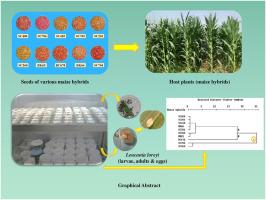玉米杂交种褐夜蛾种群生长、消化生理及抗氧化酶活性研究
IF 2.5
2区 农林科学
Q1 AGRONOMY
引用次数: 0
摘要
褐夜蛾(Leucania loreyi, Duponchel)(鳞翅目:夜蛾科)是世界上最重要的谷物害虫之一。本研究探讨了玉米(Zea mays L.)杂交种SC400、SC706、SC410、SC705、SC201、SC260、SC704、BK65、BC678和BK66对玉米叶片淀粉、蛋白质、黄酮类、花青素和酚类物质含量变化对玉米生活史、种群生长参数、消化酶活性和抗氧化防御机制的影响。目的是鉴定这些玉米杂交品种的潜在抗性性状,以提高其抵抗l.l.loreyi侵染的能力。对杂交玉米叶片的生化性状进行定量分析,发现变异显著。结果表明,SC706和SC260的发育时间较长,BK65和BC678的发育时间较短。雄性和雌性的全寿命均以SC260最高。在玉米杂交种上,黑穗病菌的内在增重率(r)在0.083 ~ 0.133天−1之间变化,SC260最低,BC678最高。在乳酸菌消化酶活性方面,SC201的蛋白水解活性最高,而SC201和BC678的淀粉水解活性均有所提高。此外,在SC410、SC260、SC706和BK65上饲养的龙井鱼,其活性氧(ROS)清除酶、过氧化物酶(POD)、超氧化物歧化酶(SOD)和过氧化氢酶(CAT)的活性均有所提高。聚类分析结果表明,BC678杂交组合最适合龙葵。然而,杂交品种SC706和SC260对该害虫的适宜性较低,这使它们成为害虫压力大的地区栽培的有希望的候选品种,并有可能降低lloreyi侵染的风险。本文章由计算机程序翻译,如有差异,请以英文原文为准。

Population growth, digestive physiology, and antioxidant enzyme activities of Leucania loreyi (Lepidoptera: Noctuidae) on maize hybrids
Leucania loreyi (Duponchel) (Lepidoptera: Noctuidae) is one of the most significant pests of cereal crops worldwide. This study explored the impact of various maize (Zea mays L.) hybrids−SC400, SC706, SC410, SC705, SC201, SC260, SC704, BK65, BC678, and BK66−on the life history and population growth parameters, digestive enzymes activities, and antioxidant defense mechanisms of L. loreyi in response to starch, protein, flavonoid, anthocyanin, and phenolic contents of leaves. The aim was to identify potential resistance traits in these maize hybrids that could improve their ability to withstand L. loreyi infestation. Quantifying the biochemical traits of the maize hybrids’ leaves revealed significant variation. Based on the results, the developmental time was longer on SC706 and SC260, and shorter on BK65 and BC678. The highest whole life span of both males and females was recorded on SC260. The intrinsic rate of increase (r) of L. loreyi varied from 0.083 to 0.133 day−1 on the studied maize hybrids, being the lowest on SC260 and highest on BC678. In terms of L. loreyi ‘s digestive enzyme activities, the highest proteolytic activity was detected on SC201, with elevated amylolytic activities also observed on both SC201 and BC678. Moreover, the activities of the reactive oxygen species (ROS)−scavenging enzymes, peroxidase (POD), superoxide dismutase (SOD), and catalase (CAT) were increased when L. loreyi reared on SC410, SC260, SC706, and BK65. The cluster analysis revealed that the BC678 hybrid was the most suitable for L. loreyi. However, the hybrids SC706 and SC260 demonstrated lower suitability to the pest, making them promising candidates for cultivation in areas with high pest pressure, and potentially reducing the risk of L. loreyi infestation.
求助全文
通过发布文献求助,成功后即可免费获取论文全文。
去求助
来源期刊

Crop Protection
农林科学-农艺学
CiteScore
6.10
自引率
3.60%
发文量
200
审稿时长
29 days
期刊介绍:
The Editors of Crop Protection especially welcome papers describing an interdisciplinary approach showing how different control strategies can be integrated into practical pest management programs, covering high and low input agricultural systems worldwide. Crop Protection particularly emphasizes the practical aspects of control in the field and for protected crops, and includes work which may lead in the near future to more effective control. The journal does not duplicate the many existing excellent biological science journals, which deal mainly with the more fundamental aspects of plant pathology, applied zoology and weed science. Crop Protection covers all practical aspects of pest, disease and weed control, including the following topics:
-Abiotic damage-
Agronomic control methods-
Assessment of pest and disease damage-
Molecular methods for the detection and assessment of pests and diseases-
Biological control-
Biorational pesticides-
Control of animal pests of world crops-
Control of diseases of crop plants caused by microorganisms-
Control of weeds and integrated management-
Economic considerations-
Effects of plant growth regulators-
Environmental benefits of reduced pesticide use-
Environmental effects of pesticides-
Epidemiology of pests and diseases in relation to control-
GM Crops, and genetic engineering applications-
Importance and control of postharvest crop losses-
Integrated control-
Interrelationships and compatibility among different control strategies-
Invasive species as they relate to implications for crop protection-
Pesticide application methods-
Pest management-
Phytobiomes for pest and disease control-
Resistance management-
Sampling and monitoring schemes for diseases, nematodes, pests and weeds.
 求助内容:
求助内容: 应助结果提醒方式:
应助结果提醒方式:


